The Science of Formula 1 Design: Expert analysis of the anatomy of the modern Grand Prix car
4.5
Reviews from our users

You Can Ask your questions from this book's AI after Login
Each download or ask from book AI costs 2 points. To earn more free points, please visit the Points Guide Page and complete some valuable actions.Related Refrences:
The Science of Formula 1 Design: An Intricate Journey into Innovation and Engineering
Welcome to an exhilarating journey through the engineering marvels of modern Grand Prix cars. In "The Science of Formula 1 Design: Expert Analysis of the Anatomy of the Modern Grand Prix Car," we delve deep into the sophisticated design and technological evolution that characterizes contemporary Formula 1 vehicles. With decades of experience and a passion for motor racing, this book presents a comprehensive guide that combines historical insight with cutting-edge innovation, providing an unmatched exploration of what makes these machines both stunning and immensely fast.
Detailed Summary
"The Science of Formula 1 Design" is not just for engineers and mechanics; it's for anyone captivated by the high-speed allure and technical prowess of F1 cars. The book starts with the historical context, illustrating how Formula 1 began as a battleground for innovation. From simple machines to the complex organisms they are today, each chapter unspools the intricate changes layer by layer—from aerodynamics to power units, chassis dynamic balance, suspension sophistication, and electronic advancements.
The book explores the paradigm shifts in materials, such as carbon fiber composites and lightweight alloys, which have revolutionized the speed and safety of these vehicles. It further ventures into the realm of computational fluid dynamics (CFD) and wind tunnel testing, revealing how these processes transform aerodynamic theories into tangible design features. It's a compelling narrative that showcases each technical advancement, examining how teams balance power against efficiency and grip against aerodynamics.
Key Takeaways
- Formula 1 is at the pinnacle of automotive innovation, constantly driving forward the boundaries of what's possible in vehicle design.
- Understanding the history of car design in F1 offers insights into how certain design principles are applied and adapted over time.
- Mastery in materials science and aerodynamic capabilities provides competitive advantages that are critical in the microsecond battles of Formula 1 racing.
- The book emphasizes the importance of teamwork and collaboration among engineers, designers, and drivers to fine-tune performance enhancements.
Famous Quotes from the Book
"In a sport where innovation doesn't stroll, but sprints at breakneck velocity, every detail on the drawing board brings science one step closer to speed."
"Aerodynamics are for people who can't build engines, but in modern F1, they're critical to making the powerful engines work."
"The challenge of Formula 1 doesn't lie just on the track, but in every bead of sweat shed in the research labs, wind tunnels, and design studios."
Why This Book Matters
This book plays a vital role not only in enhancing the understanding of Formula 1 enthusiasts but also for those involved in the automotive and technology sectors. By unraveling complex engineering challenges and highlighting innovative solutions, "The Science of Formula 1 Design" serves as an educational touchstone for anyone interested in the nexus between performance engineering and motorsport strategy. The insights gained from these pages transcend the realm of racing, influencing product design, safety standards, and environmental considerations within the broader automotive industry.
Free Direct Download
You Can Download this book after Login
Accessing books through legal platforms and public libraries not only supports the rights of authors and publishers but also contributes to the sustainability of reading culture. Before downloading, please take a moment to consider these options.
Find this book on other platforms:
WorldCat helps you find books in libraries worldwide.
See ratings, reviews, and discussions on Goodreads.
Find and buy rare or used books on AbeBooks.
1484
بازدید4.5
امتیاز50
نظر98%
رضایتReviews:
4.5
Based on 0 users review
"کیفیت چاپ عالی بود، خیلی راضیام"
Questions & Answers
Ask questions about this book or help others by answering
No questions yet. Be the first to ask!



